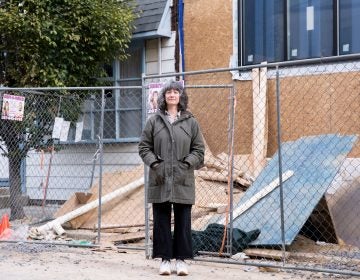When traffic studies collide
Mar. 30, 2009
By Kellie Patrick Gates
For PlanPhilly
SugarHouse’s traffic impact study overestimates the automotive traffic the casino project will bring to Delaware Avenue and underestimates the pedestrians likely to be in the vicinity, says a review commissioned by the city Commerce Department.
As a result, the study done by Sam Schwartz Engineering found the casino project has been designed with too big a parking garage and too few accommodations for bicyclists and pedestrians. SugarHouse also does not do enough to encourage the use of the Market-Frankford subway line, which has a stop at Girard Avenue, the SSE document says. Taken together, the firm says, these things may actually encourage workers and visitors who would otherwise walk, bike, or take public transit to the casino to instead use their cars.
“SSE believes that poor methodology and inappropriate assumptions were used in the analysis,” the report to the Commerce Department states. “The result is an auto-centric, suburban transportation plan in a downtown urban location.”
Schwartz recommends re-doing the SugarHouse design with a smaller parking garage and more emphasis on other means of transportation – walking, biking and mass transit.
But no major design changes are likely.
“We have to recognize that they have an approved plan of development,” Andy Altman, Deputy Mayor for Commerce and Planning, said in a phone interview Monday morning. “That doesn’t mean we can’t work with them on design changes, or on traffic issues or other things raised in the report,” he said. “But are we expecting a radical, new design? That I don’t imagine.”
At the dawn of the Nutter administration, officials said they would work to move both SugarHouse and Foxwoods off the waterfront. Foxwoods volunteered to explore a Market East location, but SugarHouse never budged.
In recent weeks, Governor Ed Rendell and some state legislators from out of the area applied hard pressure to the administration, saying if the city kept fighting casinos, gaming revenue slated to reduce taxes in Philadelphia and pay for the Convention Center expansion might be kept from the City. Nutter held a press conference in attempt to dissuade anyone who had doubts that he supported the casinos, and he stated that he would work to see them open here. And his team said the focus had shifted from resiting to redesign.
Last week, the State Supreme Court issued a decision that made it clear they didn’t believe Nutter. In response to a SugarHouse complaint that the city was stalling, the Court appointed a Special Master to oversee dealings between the city and SugarHouse.
“We’re at a point where we want to work with them on approvals,” Altman said. “The court case is done, the special master ruling came in, the foundation permit has been issued, and now it’s time to really roll up our sleeves together and work collaboratively.”
While stressing that the city was never trying to be obstructionist, Altman gave another reason for the new level of cooperation: “We’re in an economy where jobs are important, where revenue is important,” he said. “These (casinos) are significant in terms of jobs for the city and revenue for the city.”
The City can and will still work with SugarHouse on traffic and design issues, he said, but within that framework. “We’re working with them in context here,” he said. “We’re not starting from scratch.”
SugarHouse stands by its traffic report, done by Gannett Fleming, said spokeswoman Leigh Whitaker. Casino officials are willing to talk about making some changes to their design, she said, but nothing that they believe would be detrimental to the project, or inconceivable in the current economic climate.
“Over the last three years our traffic impact study has undergone intense review by the City Streets Department and PennDOT, the two agencies responsible for such reviews and the issuance of a Highway Occupancy Permit,” Whitaker said. The Gaming Control Board has also reviewed the study, she said. “At the end of the Highway Occupancy Permit process, we are fully confident that Gannett Fleming will satisfy the concerns of the City and PennDOT, and will ensure that the SugarHouse Casino is a safe and convenient facility for pedestrians and cars alike.”
Both Altman and Terry Gillen, the executive director of the Redevelopment Authority and Nutter’s point person on casinos, stressed to PlanPhilly that the city has not endorsed the Schwartz study, for which it paid about $48,000.
The same point was made to Hilary Regan, a neighborhood activist from Northern Liberties who opposes SugarHouse’s waterfront site.
“Neither the City of Philadelphia nor the Administration has accepted the assumptions or conclusions contained in the study,” wrote City Solicitor Shelley Smith in a memo sent along with the study to Regan.
“This study is not intended to convey or reflect the official views or policies of the City of Philadelphia and/or its administration,” Smith wrote in the memo, which was also attached when the study was emailed to PlanPhilly.
Altman said the point is that the city has not and will not take any action to make the Schwartz study official policy. The study will be considered along with a lot of other information as negotiations progress with the casino, he said.
The ideas contained within the Schwartz report coincide with the Vision for the Central Delaware, the related Action Plan, and the recommendations of a group of design experts who gathered last summer to brainstorm whether the existing SugarHouse and Foxwoods casino designs worked with the waterfront vision, and if changes could make them a better fit.
The documents were put together by Penn Praxis, the clinical arm of the Penn School of Design, based on more than a year of public input. The similarities between these documents and the Schwartz report are not surprising, since engineers from Schwartz were involved in the entire Delaware visioning process, either as a consultant paid by Penn Praxis or an invited participant.
The Schwartz study directly cites the Civic Vision for the Central Delaware – the goals on which the Action Plan is based – when it suggests that the City has the opportunity to “completely rethink” the waterfront and its transportation network.
“A preliminary analysis indicates that Delaware Avenue, in the area of the project site, could be reduced to only two travel lanes in each direction with a manageable impact on intersection delay. The extra right-of-way could be used to widen sidewalks on either side of Delaware Avenue, create fully separated (class I) bicycle lanes, or accommodate bus-only lanes.”
The Action Plan has been endorsed by Nutter, and the Planning Commission will review it next month. Commission Director Alan Greenberger has said he will recommend the Commission adopt the principles of the Action Plan and use them when creating a new master plan for the waterfront and setting the guidelines for a proposed zoning overlay that, if adopted by City Council, would govern development until the master plan is finished – about 16 months from now.
“The forthcoming master plan led by the Planning Commission should guide the discussion about the design of Delaware Boulevard, the integration of mass transit and the diminishment of the dependence on I-95 and the automobile for waterfront-related development,” said Penn Praxis Executive Director Harris Steinberg. “To be a serious contender in the post-carbon economy we must take steps now to build the infrastructure for a multi-modal, 21st century competitive regional urban hub. Increasing automobile driving and parking capacity is a step backwards not forward.”
The Schwartz study is dated September 9, 2008. Regan said she’s been trying to get a copy of it since November, after she heard Gillen talk about it at a Northern Liberties meeting.
PlanPhilly received the same document and attached memo from Smith about a week after submitting a written request.
Regan said she cannot fully assess what she’s reading because the document that she was given is only a summary. (When asked about this, Altman said the report provided to PlanPhilly and requesting members of the public was complete.) But based on what she’s seen, she is concerned that the Schwartz analysis – like SugarHouse’s own traffic study – looks at SugarHouse traffic in a vacuum. More specifically, Regan thinks any SugarHouse traffic study needs to consider the impact of the 10-year construction plans for I-95.
Regan predicts the construction will result in congestion, not only along the highway, but along Delaware Avenue. And what worries her more than any inconvenience is the thought of the additional exhaust produced by idling engines. “There is a strong relationship between congestion and air quality,” she said.
Regan also wishes that Schwartz had held a neighborhood meeting while doing the study. She thinks the traffic engineers could have received valuable information about traffic patterns from people who live near Delaware Avenue. And now, she wants the city to discuss the study at a public meeting.
She does not want a casino – redesigned or not – on the waterfront.
“I don’t think you can redesign a casino to fit into a world class waterfront,” she said.
The city has spoken to SugarHouse’s main investor, Neil Bluhm, about design changes on two occasions – informally in a hotel room at last year’s Democratic National Convention (Bluhm is a big donor) and later during a meeting at City Hall. Further talks are expected, but none have been scheduled.
Whitaker said SugarHouse is willing to discuss the City’s design concerns. “Neil (Bluhm) made it clear he wants us to sit down with them, and if there are ways to accommodate their concerns, we absolutely will do it,” she said. “But there may be some things we can’t accommodate.”
SugarHouse can and will take steps to encourage both employees and patrons to take public transit, Whitaker said. For example, she said, one idea now under discussion is sending a van to pick up employees at the train stations each day. But that doesn’t mean the casino can shrink its garage, she said.
“We can encourage our employees to get on SEPTA, and our patrons to get on SEPTA, but there is no way to guarantee they will,” she said. “We need to make sure our facility will accommodate our guests, and also make sure that they are not parking in front of people’s houses in the neighborhoods.”
Foxwoods officials have told the city that they will bring them design proposals for a casino at Market East, but before designs can be made, Foxwoods must reach a lease agreement with the Pennsylvania Real Estate Trust. PREIT would be Foxwoods’ landlord at either the Burlington Coat Factory or Strawbridge’s location.
“If they decide to go with The Gallery, or Strawbridge’s, either location is acceptable to us,” Altman said. “As soon as they work out their business concerns, we’re prepared to move forward quickly.”
The city may have adopted a cooperative spirit with the casinos, but others are continuing their efforts to keep both Foxwoods and SugarHouse out of Philadelphia – or at least away from residential areas.
Casino-Free Philadelphia has called the mayor’s stated desire to get the casinos up and running a betrayal.
Asian Americans United will take a bus load of Chinatown activists who oppose a Market East site to Harrisburg next week. The state Gaming Control Board has summoned officials from both casinos to an April 8th meeting. The Board wants to know what factors have caused the long delays in construction.
Contact the reporter at kelliespatrick@gmail.com.
Learn more:
SugarHouse’s Traffic Study
WHYY is your source for fact-based, in-depth journalism and information. As a nonprofit organization, we rely on financial support from readers like you. Please give today.






